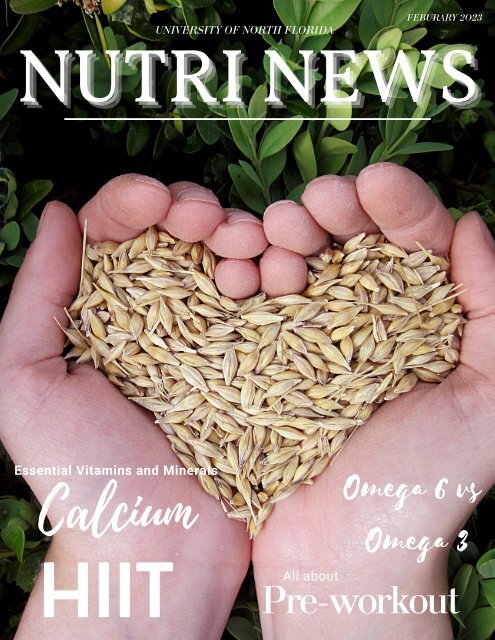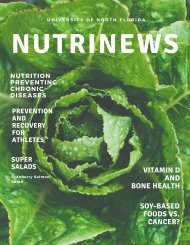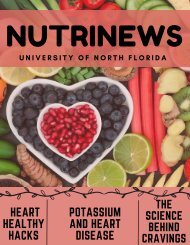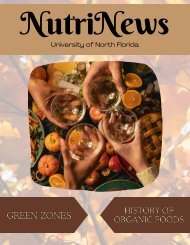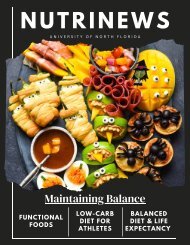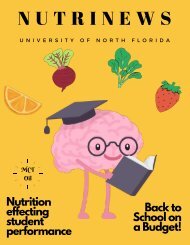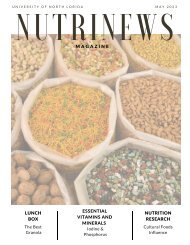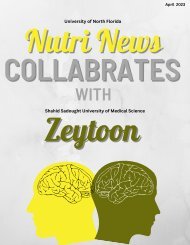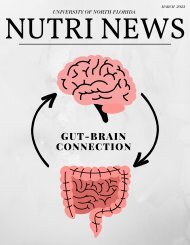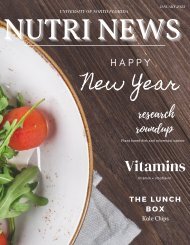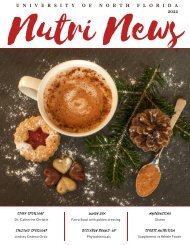Nutri News February 2023
This month theme is Heart Health!!! You will find articles about: • Since this month theme is heart health our monthly hack brings you 9 easy things you can take at home to improve heart health!! • Do you want to eat more vegetables but don’t know how? Check out the lunch box article for a delicious veggie pot pie recipe that the entire family will love! • Are you looking to spice up your workout routine? Look no further, HIIT training is a heart-friendly cardio workout with a blend of aerobic exercise and strength training!!! Check page 25 for more info • Have you ever wondered what’s the difference between omega-3 and omega-6? Let’s talk fats! • Salt vs Sugar, who is the real culprit? Find out the truth in page 15! • If you go to the gym or partake in any physical related activities you might have heard or use pre-workout to get that extra pump of energy, but have you ever stopped to think about the actual mechanism of pre-workout? Go check page 6 for the pros and cons of pre-workout you might learn a thing or two!! • Calcium is a mineral mainly associated with bone and teeth health, but did you know that calcium plays a very important function in heart health? Check out our essential guide to vitamins and minerals article to learn more!! This month’s student spotlight is Lyla Palompo, check what she has to say in page 21! If you are looking to make an impact on campus as well as in the community, look for the fliers highlighting volunteer opportunities. These amazing programs are always looking for more volunteers. It is amazing the difference we can make when we all work together for a better and healthier tomorrow. Happy reading!
This month theme is Heart Health!!!
You will find articles about:
• Since this month theme is heart health our monthly hack brings you 9 easy things you can take at home to improve heart health!!
• Do you want to eat more vegetables but don’t know how? Check out the lunch box article for a delicious veggie pot pie recipe that the entire family will love!
• Are you looking to spice up your workout routine? Look no further, HIIT training is a heart-friendly cardio workout with a blend of aerobic exercise and strength training!!! Check page 25 for more info
• Have you ever wondered what’s the difference between omega-3 and omega-6? Let’s talk fats!
• Salt vs Sugar, who is the real culprit? Find out the truth in page 15!
• If you go to the gym or partake in any physical related activities you might have heard or use pre-workout to get that extra pump of energy, but have you ever stopped to think about the actual mechanism of pre-workout? Go check page 6 for the pros and cons of pre-workout you might learn a thing or two!!
• Calcium is a mineral mainly associated with bone and teeth health, but did you know that calcium plays a very important function in heart health? Check out our essential guide to vitamins and minerals article to learn more!!
This month’s student spotlight is Lyla Palompo, check what she has to say in page 21!
If you are looking to make an impact on campus as well as in the community, look for the fliers highlighting volunteer opportunities. These amazing programs are always looking for more volunteers. It is amazing the difference we can make when we all work together for a better and healthier tomorrow.
Happy reading!
Create successful ePaper yourself
Turn your PDF publications into a flip-book with our unique Google optimized e-Paper software.
FEBURARY 2O23<br />
UNIVERSITY OF NORTH FLORIDA<br />
NUTRI NEWS<br />
<br />
Essential Vitamins and Minerals<br />
Calcium<br />
HIIT<br />
Omega 6 vs<br />
Omega 3<br />
All about<br />
Pre-workout
TABLE OF<br />
CONTENT<br />
04.<br />
06.<br />
YOUR ESSENTIAL GUIDE TO VITAMINS<br />
AND MINERALS<br />
Calcium<br />
NUTRITION SCIENCE<br />
All about Pre-workout<br />
10.<br />
MONTHLY HACKS<br />
9 Tips to Improve Heart Health<br />
15.<br />
17.<br />
MYTHBUSTING<br />
Salt vs Sugar<br />
THE LUNCH BOX<br />
Veggie Pot Pie<br />
18.<br />
RESEARCH ROUND UP<br />
Does the Frequency of Adding Salt<br />
Increase Cardiovascular Disease?<br />
EAT<br />
WELL<br />
LIVE<br />
WELL<br />
STUDENT SPOTLIGHT<br />
21. Lyla Palompo<br />
25.<br />
27.<br />
30.<br />
SPORTS NUTRITION<br />
Effects of HIIT training on Heart Health<br />
NUTRITION RESEARCH<br />
Omega 6 vs Omega 3 with Heart Health<br />
NUTRINEWS STAFF<br />
2<br />
Follow us!<br />
@unfnutrinews
N U T R I N E W S<br />
M A G A Z I N E<br />
S E I Z E<br />
T H E<br />
D A Y &<br />
V O L U N T E E R<br />
P O S I T I O N S A V A I L A B L E<br />
<br />
E D I T O R S<br />
W R I T E R S<br />
P U B L I S H E R S<br />
P U B L I C R E L A T I O N S W E B S I T E M A N A G E R<br />
<br />
<br />
C O N T A C T S A I L Y M E D E R O<br />
N 0 1 4 4 0 5 5 6 @ U N F . E D U
Your Essential Guide to<br />
Vitamins and Minerals<br />
Calcium and the Heart<br />
Written By:<br />
Ashley Valle<br />
What Does Calcium Have to Do with The<br />
Heart?<br />
A mineral necessary for various functions –<br />
calcium is most known for its impact on our<br />
bone health. Other functions of calcium include<br />
muscle contraction, blood clotting, & hormone<br />
release1,2. However, we'll be concentrating on<br />
its crucial function in maintaining heart health.<br />
Calcium contributes to the contraction of the<br />
heart, which pumps blood through our bodies3,<br />
in a study conducted by researchers of the<br />
Cedars-Sinai Heart Institute titled the Oregon<br />
Sudden Unexpected Death study, participants<br />
with low calcium had an almost 2.5x increase in<br />
the possibility of sudden cardiac arrest4. When<br />
the heart suddenly stops beating, it is known as<br />
cardiac arrest, which results in 9 fatalities out of<br />
every 10. This study also highlights the<br />
relationship between coronary heart disease<br />
and the risk of sudden cardiac arrest, pointing<br />
out that over half of all cases of sudden cardiac<br />
arrest resulting in death across both men and<br />
women occur in people with zero history of<br />
heart disease4.<br />
Although further study is needed to confirm<br />
the relationship between calcium deficiency<br />
and heart failure, it is important to keep in<br />
mind the importance of balanced nutrition in<br />
the grand scheme of our bodies function and<br />
consume adequate calcium – not just for<br />
bones but for the body as a whole!<br />
RDA Recommendations for Calcium &<br />
Dietary Sources<br />
Since childhood, milk has been advertised to<br />
be the best source of calcium a growing child<br />
can consume. However, there are many other<br />
foods that have just about the same amount<br />
of calcium per serving as milk (240mg) such<br />
as yogurt (260mg), cooked spinach (310mg),<br />
green cabbage (280mg) and soy milk<br />
(210mg)5. Other sources of calcium include<br />
but are not limited to parmesan cheese,<br />
broccoli, rye bread, sardines with bones and<br />
fortified breakfast cereals5.<br />
Although many of these sources listed are<br />
dairy, there are plenty of nondairy sources of<br />
calcium that are suitable for those with<br />
4
lactose intolerance, milk allergy, or who<br />
practice veganism. Recommended daily intake<br />
of calcium for adults ages 19-50 years and men<br />
51-70 is 1,000mg, with adult women 51-70<br />
being slightly higher at 1,200mg due to postmenopausal<br />
bodies retaining less calcium2.<br />
What Happens if You Have Too Much<br />
Calcium?<br />
Despite the need for more research, it is<br />
important to mention the possible<br />
relationship between excess calcium through<br />
supplementation and the risk of<br />
cardiovascular disease2. Aside from this,<br />
excess calcium can contribute to various<br />
symptoms such as compromised kidney<br />
function, constipated, frequent urination, low<br />
phosphate, and more2. The daily upper limit<br />
for adults ages 19-50 is 2,500mg – roughly 10<br />
servings of milk to put it into perspective.<br />
Who Is at Risk for Calcium Deficiency & What<br />
Can Happen?<br />
Unfortunately, there are certain groups of<br />
people who are more at risk of developing<br />
calcium deficiency. This includes postmenopausal<br />
people and people who don’t<br />
consume dairy2. As previously mentioned,<br />
post-menopausal people have reduced<br />
ability to retain calcium in their bodies,<br />
resulting in a higher risk for deficiency2.<br />
People who do not consume dairy are also at<br />
higher risk due to many calcium sources<br />
being dairy based – this is not to say people<br />
who do not consume dairy will inevitably<br />
become calcium deficient, but it is important<br />
to know and have a well-planned diet to<br />
avoid nutrient deficiencies.<br />
Not getting enough calcium can result in<br />
several symptoms and conditions,<br />
osteoporosis which causes fragile bones,<br />
osteomalacia (soft bones), rickets (soft bones<br />
in children), poor appetite, muscle weakness,<br />
and abnormal heart rate1,2.<br />
Fun Facts<br />
99% of the body’s calcium is stores in the<br />
bones1<br />
Vitamin D and Calcium are besties!<br />
Adequate vitamin D is essential for the<br />
metabolism of calcium6<br />
Calcium aids in the prevention of kidney<br />
stones6<br />
Certain foods can increase the need for<br />
calcium consumption such as excess<br />
alcohol, high sodium foods, and dark<br />
sodas1<br />
References:<br />
1. Calcium. The <strong>Nutri</strong>tion Source. https://www.hsph.harvard.edu/nutritionsource/calcium/. Published October 19, 2020. Accessed January 1, <strong>2023</strong>.<br />
2. Office of dietary supplements - calcium. NIH Office of Dietary Supplements. https://ods.od.nih.gov/factsheets/Calcium-Consumer/. Accessed January 1, <strong>2023</strong>.<br />
3. Authors Sophie Phillips, Authors Subhrajit Barua, Authors Ana Spasojevic, Authors Thomas Roder. The role of calcium in the human heart: With great power comes great responsibility. Frontiers for<br />
Young Minds.<br />
4. Low calcium may raise cardiac arrest risk by twofold. Medical <strong>News</strong> Today. https://www.medicalnewstoday.com/articles/319672. Accessed January 1, <strong>2023</strong>.<br />
5. How can I get enough calcium? - informedhealth.org - NCBI bookshelf. https://www.ncbi.nlm.nih.gov/books/NBK279330/.<br />
6. Dr. Edward Group DC. 10 facts about calcium. Dr. Group's Healthy Living Articles. https://explore.globalhealing.com/10-facts-about-calcium/. Published May 22, 2013. Accessed January 1, <strong>2023</strong>.<br />
6
<strong>Nutri</strong>tion Science<br />
W R I T T E N B Y :<br />
I S A B E L L E B R A Z E L T O N<br />
All About<br />
Pre-Workout<br />
For many people, finding the time and<br />
energy to work out can be difficult. Preworkout<br />
supplements have gained a lot of<br />
popularity because they are reported to<br />
enhance energy and maximize workout<br />
efforts; this helps people have the capacity<br />
to begin their workouts and reach their<br />
goals each workout session.¹ Some<br />
examples of pre-workout supplements that<br />
are commonly used include snack bars, premixed<br />
drinks, powdered supplements, and<br />
pills. Unfortunately, as with most things,<br />
there are some concerns that come along<br />
with the benefits of pre-workout<br />
supplements.<br />
Potential Benefits<br />
As mentioned above, the main benefits of<br />
using pre-workout are stated to be<br />
increased energy and performance, as well<br />
as enhanced focus and endurance.¹<br />
Additionally, it is reported that some preworkout<br />
supplements help enhance<br />
recovery after working out by reducing<br />
muscle damage and possibly aiding in injury<br />
recovery. While there can be many<br />
ingredients in pre-workout supplements,<br />
the most notable ingredients that are<br />
responsible for these praised effects are<br />
caffeine, creatine, and beta-alanine.<br />
6
Caffeine is one of the most popular<br />
ingredients in pre-workouts due to its<br />
ability to raise energy levels and sharpen<br />
focus.¹ Moreover, research has shown that<br />
caffeine can positively impact muscle<br />
strength and power. Creatine is another<br />
popular ingredient due to extensive<br />
research suggesting its ability to support<br />
athletic performance and aid in postworkout<br />
recovery. Finally, beta-alanine has<br />
been linked to potentially increased<br />
endurance and strength while working out<br />
when consumed in recommended<br />
quantities. Overall, while more research<br />
needs to be conducted, recent research has<br />
found that the consumption of multiingredient<br />
pre-workout supplements can<br />
improve athletic performance, increase<br />
strength, and bolster endurance.<br />
Potential Concerns<br />
The biggest concern related to pre-workout<br />
consumption comes from some ingredients’<br />
side effects.¹,² These concerns include<br />
trouble sleeping, upset stomach, increased<br />
heart rate, anxiety induced by caffeine,<br />
increased diastolic blood pressure induced<br />
by creatine, and short-term tingling and<br />
flushed skin caused by beta-alanine and<br />
niacin. These side effects can be regulated<br />
by closely monitoring ingredient doses and<br />
individual tolerance and sensitivity. Some<br />
ingredients found in pre-workout<br />
supplements may also have interactions<br />
with certain medications, making it<br />
necessary to consult a medical professional<br />
before beginning use.<br />
Additionally, individuals with existing<br />
health conditions may have adverse<br />
reactions to pre-workout supplements if<br />
precautions are not taken.¹,² Long-term use<br />
of pre-workout supplements<br />
can be particularly problematic and<br />
dangerous for those who have<br />
cardiovascular conditions and high blood<br />
pressure, and chronic supplement use may<br />
cause damage to the liver which can lead to<br />
further problems.² Ultimately, it is<br />
important to consult with a medical<br />
professional before starting the intake of<br />
any supplements and to research the safety<br />
and credibility of a supplement that you<br />
want to try before starting it.<br />
7
References<br />
1. Bubnis, D. (no date) Potential preworkout<br />
side effects and how to reduce<br />
them, Medical <strong>News</strong> Today. MediLexicon<br />
International. Available at:<br />
https://www.medicalnewstoday.com/article<br />
s/pre-workout-side-effects#benefits<br />
(Accessed: January 1, <strong>2023</strong>).<br />
2. Smith, A. (2022) 18 pre-workout side<br />
effects to be aware of, Discover Magazine.<br />
Discover Magazine. Available at:<br />
https://www.discovermagazine.com/lifestyl<br />
e/18-pre-workout-side-effects-to-beaware-of<br />
(Accessed: January 1, <strong>2023</strong>).<br />
8
M O N T H L Y H A C K S<br />
9 Tips to Improve Heart Health<br />
That Can Be Done at Home<br />
<br />
Written by:<br />
Sophia Harris<br />
Did you know that you can take action to<br />
protect your heart? You do not need any<br />
fancy equipment or extraordinarily expensive<br />
medications to do so. The tips below will<br />
discuss various ways to improve your heart<br />
health with lifestyle changes!<br />
<strong>Nutri</strong>tion<br />
One way to improve your heart health would<br />
be through nutrition, adding fish to your diet<br />
is an excellent way to improve your<br />
nutritional status. Some fish contain omega-<br />
3 fatty acids which protect the heart from<br />
disease and stroke.2 Foods that belong in<br />
this section are: salmon, tuna, and trout.2<br />
Adding foods that contain monounsaturated<br />
or polyunsaturated fats is also beneficial<br />
since they protect the heart from disease.2<br />
Food that falls into this category are: walnuts,<br />
seed butters, sunflower seeds, pumpkin<br />
seeds, almonds, pine nuts, avocados, tofu,<br />
olive oil, sesame oil, and canola oil.2<br />
10<br />
Another food group that is heart<br />
healthy are whole grains.1 These food<br />
items include: oatmeal, brown rice,<br />
and whole grain breads and<br />
tortillas.2 Leafy greens like cabbage,<br />
spinach, collard greens, and kale2<br />
are greens that are going to reduce<br />
the risk of developing cardiovascular<br />
disease. It is important to keep in<br />
mind that there is no need to<br />
eliminate foods you enjoy eating,<br />
adding more of the foods listed<br />
above is a great way to protect<br />
yourself from heart disease without<br />
sacrificing the foods you love.
Exercise<br />
Another way that you can prevent the development of heart disease is to<br />
find a way to move your body with some exercise.1 The types of exercise<br />
that aid in heart health are aerobic exercise and resistance training.4<br />
Aerobic exercise helps lower blood pressure and heart rate as well as<br />
controlling your blood glucose.4 They do not need to be super exhausting<br />
and hard training. A few examples of aerobic exercises are swimming,<br />
cycling, brisk walking, jump roping and even playing tennis.4 It is important<br />
to participate in aerobic exercise for at least 30 minutes a day and for at<br />
least 5 days a week.4<br />
Resistance training can increase HDL or good cholesterol and reduce LDL or<br />
bad cholesterol.4 Some examples of this type of exercise are: working out<br />
with free weights or with resistance bands.4 You can participate in<br />
resistance training on two nonconsecutive days.4 Some people may have a<br />
hard time doing exercise for a full 30 minutes due to a busy schedule. But<br />
planning blocks of time where you can do so can be highly beneficial for<br />
your heart health!<br />
Everything in Moderation<br />
Another way to maintain heart health is moderation. There are some food<br />
and drinks products that can hurt your heart in the long run if you tend to<br />
splurge on them, like alcohol.1 You do not need to completely avoid these<br />
types of products, but it is important to enjoy them in moderation.<br />
Hygiene<br />
An additional tip that can help preserve the health of your heart would be to<br />
wash your hands often.3 Illnesses like the flu and pneumonia can be tough<br />
on the heart can make the heart work harder than it usually would.3<br />
Washing your hands often can help your body fight against these heart<br />
threatening diseases.<br />
<br />
11
Hygiene<br />
An additional tip that can help preserve the health of your heart would be to wash your<br />
hands often.3 Illnesses like the flu and pneumonia can be tough on the heart can<br />
make the heart work harder than it usually would.3 Washing your hands often can help<br />
your body fight against these heart threatening diseases.<br />
<br />
Tobacco<br />
Another heart healthy tip would be to avoid tobacco and secondhand smoking when<br />
you can.1 Tobacco products can increase the buildup of plaque in your blood vessels<br />
which can lead to blood clots and other harmful symptoms.5<br />
Blood Pressure<br />
It is also vital to maintain your heart health by checking on your blood pressure.1 You<br />
should begin checking your blood pressure regularly once you reach the age of 18<br />
since you cannot tell if you have high blood pressure since it does not display any<br />
symptoms.1 You can go to a doctor, or you can purchase an at-home blood pressure<br />
monitor. If you wish to purchase an at-home blood pressure monitor, you find one as<br />
the price ranges from $20 to $100.<br />
Cholesterol<br />
Cholesterol should also be monitored and should be checked at least every five years.1<br />
You can also purchase a cholesterol home testing kit if you cannot visit a doctor's<br />
office. You can find them at your local pharmacy or at a medical supply store and they<br />
are usually under $20.<br />
Education<br />
Lastly, make sure that you remember the signs of a heart attack so that you can get<br />
help as soon as you display any symptoms.1 Usually a heart attack is sudden, but<br />
sometimes the symptoms become apparent hours or even days before it happens.1<br />
One early sign of a heart attack is feeling unusually tired.1 Other symptoms include:<br />
trouble breathing, nausea, feeling dizzy, a cold sweat, stomachache, heartburn, pain<br />
or discomfort in the upper body or in the center/left side of the chest.1 This can feel<br />
like a squeeze or fullness.1 You may feel the discomfort or pain in your arms, back,<br />
shoulders, neck, jaw, or upper stomach.1<br />
<br />
<br />
<br />
12
References<br />
1. Office of Disease Prevention and Health Promotion. Health Conditions: Keep Your Heart Healthy.<br />
MyHealthfinder website. Updated December 22, 2022. Accessed January 1, <strong>2023</strong>.<br />
https://health.gov/myhealthfinder/health-conditions/heart-health/keep-your-heart-healthy#thebasics-tab<br />
2. National Heart, Lung, and Blood Institute. Heart Healthy Living: Choose Heart-Healthy Foods. National<br />
Heart, Lung, and Blood Institute website. Updated March 24, 2022. Accessed January 1, <strong>2023</strong>.<br />
https://www.nhlbi.nih.gov/health/heart-healthy-living/healthy-foods<br />
3. Harvard Health Publishing. 10 small steps for better heart health. Harvard Health Publishing website.<br />
Published December 16, 2019. Accessed January 1, <strong>2023</strong>. https://www.health.harvard.edu/healthbeat/10-<br />
small-steps-for-better-heart-health<br />
4. John Hopkins Medicine. 3 Kinds of Exercise That Boost Heart Health. John Hopkins Medicine website.<br />
Accessed January 1, <strong>2023</strong>. https://www.hopkinsmedicine.org/health/wellness-and-prevention/3-kindsof-exercise-that-boost-hearthealth#:~:text=%E2%80%9CAerobic%20exercise%20and%20resistance%20training,D<br />
5. Center for Disease Control and Prevention. Smoking and Cardiovascular Disease. Center for Disease<br />
Control and Prevention website. Accessed January 1, <strong>2023</strong>. https://www.cdc.gov/tobacco/sgr/50thanniversary/pdfs/fs_smoking_CVD_508.pdf<br />
13
BLACK<br />
HISTORY<br />
MONTH<br />
<strong>February</strong> 1st <strong>2023</strong>
M Y T H B U S T I N G<br />
salt vs sugar<br />
Written By:<br />
Dahnine McCune-Moyer<br />
Salt and sugar are two substances commonly used in<br />
cooking and food preparation. While both are essential for<br />
adding flavor to food, their nutritional value and potential<br />
health effects differ.<br />
Salt, also known as sodium chloride, is a mineral that is<br />
essential for maintaining electrolyte balance in the body<br />
and for proper muscle and nerve function. However,<br />
consuming too much salt can have negative health<br />
consequences, such as increasing the risk of high blood<br />
pressure, heart disease, and stroke.1 The American Heart<br />
Association recommends limiting daily sodium intake to no<br />
more than 2,300 milligrams, or about one teaspoon.<br />
Sugar, meanwhile, is a carbohydrate that provides quick<br />
energy for the body. While small amounts of sugar can be<br />
part of a healthy diet, consuming too much sugar can<br />
contribute to weight gain and increase the risk of chronic<br />
diseases, such as metabolic disease and heart disease.2<br />
The World Health Organization recommends limiting added<br />
sugars to no more than 10% of daily calorie intake, which is<br />
equivalent to about 50 grams or 12 teaspoons for an adult<br />
following a 2,000-calorie-per-day diet.3<br />
One key difference between salt and sugar is that salt is<br />
essential for the body to function correctly, while sugar is<br />
not. Salt is necessary for maintaining electrolyte balance<br />
but consuming too much can negatively affect health. On<br />
the other hand, sugar provides quick energy but does not<br />
have any essential nutrients, and it can be harmful if<br />
consumed in excess.<br />
15
Another difference between the two is the way they are used in cooking and food preparation. Salt is<br />
often used to enhance flavor, while sugar is often used to sweeten foods and drinks. Salt is also a<br />
preservative, while sugar is used in fermentation to create products like bread and beer.<br />
In conclusion, salt and sugar are essential for adding flavor to food, but their nutritional value and<br />
potential health effects differ. While it is important to consume salt in moderation, it is vital for<br />
maintaining electrolyte balance in the body. Ingesting too much sugar, on the other hand, can<br />
contribute to weight gain and increase the risk of chronic diseases.4 It is essential to pay attention to<br />
the amount of salt and sugar in our diets and choose foods that are lower in these substances<br />
whenever possible.<br />
References<br />
1. He FJ, Tan M, Ma Y, MacGregor GA. Salt Reduction to Prevent Hypertension and Cardiovascular Disease. J Am Coll Cardiol.<br />
2020;75(6):632-647. doi:10.1016/j.jacc.2019.11.055<br />
2. Stanhope KL. Sugar consumption, metabolic disease and obesity: The state of the controversy. Crit Rev Clin Lab Sci.<br />
2016;53(1):52-67. doi:10.3109/10408363.2015.1084990<br />
3. Guideline: Sugars Intake for Adults and Children. World Health Organization. Accessed January 1, <strong>2023</strong>.<br />
https://www.ncbi.nlm.nih.gov/books/NBK285538/#:~:text=WHO%20recommends%20a%20reduced%20intake<br />
4. Freeman CR, Zehra A, Ramirez V, Wiers CE, Volkow ND, Wang GJ. Impact of sugar on the body, brain, and behavior. Front Biosci<br />
(Landmark Ed). 2018;23(12):2255-2266. doi:10.2741/4704<br />
16
T H E L U N C H B O X<br />
V E G G I E P O T P I E<br />
Written by:<br />
Kate Overby<br />
Recently, I found myself craving home-made comfort food- Veggie Pot Pie. It was 45 degrees<br />
which is nearly freezing in the mind of a Floridian. This concoction hit the spot and although it is<br />
fully plant-based, it is simple enough to make it into a non-vegan version. Just mix in baked<br />
chicken and top with sprinkled cheese. Valentine’s day dinner? I think yes.<br />
Ingredients<br />
-1 tbsp extra virgin olive oil<br />
-½ chopped white onion<br />
-2 cloves minced garlic<br />
-1 cup cubed gold potatoes<br />
-2 cups frozen mixed<br />
vegetables (peas, carrots,<br />
green beans, corn, etc.)<br />
-4 tbsp all-purpose flour<br />
-4 tbsp vegan butter<br />
-1 ½ cup vegetable broth<br />
-Salt and pepper to taste<br />
-1 tub Original Bitchin’ Sauce<br />
(can find at Target, Sprouts,<br />
Whole Foods, and more)<br />
1 tin crescent roll dough<br />
Instructions<br />
1.Preheat oven to 400 degrees F<br />
2.To a skillet, add chopped onion, garlic, and olive oil. Sauté until onion is nearly translucent<br />
3.Add cubed potatoes and continue to sauté for 4-6 minutes<br />
4.Add frozen vegetables and stir<br />
5.Add butter<br />
6.Once butter is melted, add flour, and stir quickly to avoid lumps in the mixture<br />
7.Add vegetable broth and allow mixture to boil and thicken<br />
8.Season with salt and pepper, mix, and remove from heat<br />
9.Pour mixture into a round pie pan<br />
10. Spread Bitchin’ Sauce on top of the filling<br />
11. Roll crescent roll dough over the sauce and vegetables and seal along the edges using<br />
your finger<br />
***Tip: Have fun and be creative with your dough. For valentine’s day, make a heart out of it.<br />
You really cannot go wrongJ<br />
12. Bake for 25 minutes and enjoy!<br />
17
Research Roundup<br />
<br />
DOES THE<br />
FREQUENCY OF<br />
ADDING SALT<br />
INCREASE<br />
CARDIOVASCULAR<br />
DISEASES?<br />
WRITTEN BY:<br />
ALICIA SCOTT<br />
18<br />
Cardiovascular disease (CVD), also<br />
known as heart disease is one the<br />
main causes of death across all<br />
genders and different racial and<br />
ethnic groups in the United States of<br />
America. In 2020, 697,000 people<br />
died from heart disease alone in the<br />
United States.¹ There is also the<br />
economic burden of heart disease<br />
which is about $229 billion in the<br />
years 2017 and 2018.¹ One major<br />
factor of CVD is hypertension, and<br />
there has been research over the<br />
years to see if there is any effect on<br />
decreasing salt intake to improve<br />
symptoms.<br />
A study in the UK with 500,000<br />
participants ranging from ages 37 to<br />
73 years old was conducted to<br />
determine if there is an association<br />
with the frequency of adding salt<br />
and the increased risk of a<br />
cardiovascular disease.²<br />
In the final analysis, a total of 176,570<br />
participants was included. The first<br />
step in the experiment was to<br />
determine a baseline of the<br />
participants salt consumption. A<br />
questionnaire was used to conduct<br />
this portion of the experiment and it<br />
included questions such as “Do you<br />
add salt to your foods?” and “Have<br />
you had any major changes in your<br />
diet in the the last 5 years?”.²<br />
Alongside filling out the<br />
questionnaire regarding salt<br />
consumption, the participants had<br />
to complete several rounds of a 24-<br />
hour diet recall. The Oxford WebQ<br />
was used for the diet recall, and it<br />
included over 200 types of foods and<br />
over 30 types of beverages.²
To check the consumption of<br />
sodium that can be measured<br />
objectively, a urinalysis was<br />
conducted. A baseline urinalysis was<br />
conducted where the amount of<br />
sodium in the urine was conducted<br />
and as the experiment progressed, a<br />
linear model was used to see the<br />
trends with salt frequency and the<br />
concentration of sodium in urinary<br />
excretion.² There were several<br />
adjustments made to the linear<br />
model such as sex, race, smoking<br />
status, alcohol consumption,<br />
frequency of<br />
physical activity, and different<br />
diseases such as diabetes, high<br />
cholesterol, cancer, chronic kidney<br />
disease (CKD), and overall energy<br />
intake.²<br />
When it came to the results of the<br />
study, researchers found that the<br />
participants that had the lowest<br />
frequency of salt addition were<br />
women, white, and those that have a<br />
lower BMI. These participants also<br />
consumed less alcohol, were more<br />
active physically, less likely to be<br />
smokers, and they adhered to the<br />
DASH diet more by increasing their<br />
intake of fruits, vegetables, legumes,<br />
and whole grains.²<br />
The study found that a lower<br />
addition of salt was associated with a<br />
lower risk of developing<br />
cardiovascular disease.² This is<br />
outside of other factors such as<br />
preexisting diseases and different<br />
lifestyle factors such as smoking and<br />
alcohol consumption. The follow<br />
process of the experiment took 11.8<br />
years and, in that time, a total of<br />
9,963 cases of different CVD were<br />
reported and these diseases ranged<br />
from ischemic heart disease, stroke<br />
and heart failure.² The addition of<br />
salt showed a greater significance in<br />
heat failure followed by ischemic<br />
heart disease than the other CVDs.<br />
There were some limitations with<br />
the study and the major one being<br />
that the sodium addition was a selfreported<br />
frequency, so it made the<br />
data more subjective. To make the<br />
data more objective where it could<br />
be measured more accurately, the<br />
urine sodium concentration was<br />
measured.2 The sound limitation is<br />
that the participants were making<br />
life-altering decisions by<br />
participating in the study. Adding<br />
salt in high frequencies can promote<br />
an unhealthy lifestyle or change<br />
dietary patterns.² Since the study<br />
was conducted in the UK, the results<br />
are based on the dietary pattern of<br />
people in that region and it does not<br />
take into account different cultural<br />
eating habits so the results are<br />
unclear when it comes to the greater<br />
population.<br />
19
References:<br />
1. Heart disease facts. Centers for<br />
Disease Control and Prevention.<br />
https://www.cdc.gov/heartdisease/fac<br />
ts.htm. Published October 14, 2022.<br />
Accessed January 7, <strong>2023</strong>.<br />
2. Ma H, Wang X, Li X, Heianza Y, Qi L.<br />
Adding salt to foods and risk of<br />
cardiovascular disease. J Am Coll<br />
Cardiol. 2022;80(23):2157-2167.<br />
doi:10.1016/j.jacc.2022.09.039<br />
20
Student<br />
Spotlight<br />
Lyla Palompo<br />
Favorite color? Sage Green<br />
Favorite food? Spam Musubi<br />
Favorite book? Every Last Word by: Tamara Ireland Stone<br />
Favorite pastime? Discovering, Playing and Listening to<br />
Music<br />
Biggest fear? Not being successful<br />
Greatest motivation? Knowing where my family is from<br />
and proving their struggles and sacrifices were worth it<br />
<br />
What inspired you to pursue your<br />
degree?<br />
There . are many moments and memories that<br />
I could describe that helped guide me to my<br />
Nursing degree, but overall my love and<br />
passionate personality for helping others is<br />
what nudged me into the right direction. At<br />
first, I was convinced that I wanted to have<br />
a career as a Music Therapist as it was a<br />
combination of the three things I enjoy the<br />
most, helping people, mental health, and<br />
music. After taking my general education<br />
courses, I found myself really enjoying<br />
Psychology and Anatomy and Physiology<br />
I/II. After taking these courses I found myself<br />
researching more about the health care field<br />
and how I can incorporate my interests in<br />
mental health to the health care field. That<br />
is when I stumbled upon the Psychiatric<br />
Mental Health Nurse Practitioner program at<br />
UNF and knew that is what I am destined to<br />
be, so the Nursing program was where I<br />
needed to be.<br />
What activities or hobbies do you enjoy<br />
doing outside of school?<br />
Outside of school I enjoy spending time with<br />
my loved ones, finding new places to eat, and<br />
playing music.<br />
What has been most challenging to you<br />
since beginning your program here at<br />
UNF?<br />
Since starting my program at UNF, the most<br />
challenging thing for me would be finding the<br />
balance between school, family and personal<br />
needs. Spending time with my family is very<br />
important to me, as is doing well in nursing<br />
school, which makes it hard to manage time for<br />
everything to be done. Learning prioritization<br />
was crucial for me to be able to get what<br />
needed to be done for school with the amount<br />
of coursework and content being covered while<br />
also having time to enjoy some quality time.<br />
21
What plans and goals do you<br />
have after graduation?<br />
My goal after graduation is finding a hospital<br />
that shares my values and promotes a healthy<br />
work environment for health care workers in<br />
which I can be a part of. After receiving my<br />
BSN, I plan to further my education by getting<br />
my MSN degree in Nursing Leadership and<br />
Administration, in which I will be able to<br />
pursue my goal of becoming a Psychiatric<br />
Mental Health Nurse Practitioner.<br />
What advice would you give to incoming<br />
students entering the UNF?<br />
Advice that I would give to incoming students<br />
although as cliché as it is, is participating on<br />
campus, whether that be utilizing what the<br />
campus has to offer like the library, the green,<br />
student union, the gym or finding out what<br />
clubs or organizations that you can devote<br />
some time to and meet new people that you<br />
wouldn’t in your regular classes or bringing<br />
friends to experience with you. Trying<br />
something new at school cannot only provide a<br />
way to spend free time but it can also give you<br />
something to look forward to and be<br />
passionate about. Another important thing<br />
would be to put yourself first, know your<br />
responsibilities but also know your limit. Stress<br />
and mental health are important to address<br />
early on, so establish routines that are suited<br />
for you to be both successful and happy.<br />
Do you have a favorite inspiring quote<br />
or mantra that you live by and would<br />
like to share with others?<br />
A family mantra made by my dad that I live by<br />
is “Follow Through” as it applies to anything<br />
and everything in life. If you set your mind to<br />
something “follow through” with what you<br />
want/need, if you start something make sure<br />
you “follow through” so it is completed, if you<br />
tell someone something you need to “follow<br />
through” with what you told them, etc.<br />
An inspiring quote that I got out of a fortune<br />
cookie that has stuck with me is “if you<br />
continually give, you will continually have.”<br />
What has been your favorite class in the<br />
nursing program?<br />
22<br />
My favorite class thus far has been Psychiatric<br />
Mental Health Nursing Concepts as this is the<br />
field I plan on specializing in. I thoroughly<br />
enjoyed learning about mental health and<br />
what role, as a nurse, I can be for people with<br />
mental health issues and promoting their<br />
safety and health with the skills i’ve learned<br />
throughout the course.
NATIONAL FREEDOM<br />
DAY<br />
<br />
FEBurary 1, <strong>2023</strong>
S P O R T S N U T R I T I O N<br />
T H E E F F E C T S O F H I I T T R A I N I N G<br />
O N H E A R T H E A L T H<br />
Written by:<br />
Asal Abbaszadeh<br />
Along with diet, exercise plays an<br />
important role in supporting a healthy<br />
metabolism and lifestyle.1 The more<br />
consistently you workout, the greater the<br />
health benefits. Exercise trains your heart<br />
to beat faster and stronger, using less<br />
oxygen to functionwell.1,2 Recent studies<br />
shows that exercise in less time can be<br />
more beneficial for your health.2,3 HIIT<br />
training offers the same fitness<br />
advantages as long-term endurance<br />
training but in a shorter amount of<br />
time.2,3<br />
So, what exactly is HIIT training? HIIT, or<br />
high-intensity interval training, is a form<br />
of exercise that involves alternating short<br />
25
ursts of intense exercise with lowerintensity<br />
recovery periods or rest.2 This<br />
heart-friendly cardio workout is a blend of<br />
aerobic exercise and strength training.2 It is<br />
commonly used in the athletic community<br />
to help build endurance and strengthen<br />
muscles. In addition, high-intensity interval<br />
training has shown to provide big benefits<br />
regarding cardiovascular health.2,3HIIT<br />
workouts can strengthen the heart and<br />
improve blood circulation.3 Interval<br />
training improves VO2 max, a measurement<br />
of the maximum volume of oxygen the<br />
heart pumps throughout the body. Raised<br />
oxygen levels helps minimizethe risk of<br />
heart diseases such as high cholesterol,<br />
coronary artery disease, and heart<br />
attacks.3 It can also improve blood<br />
pressure and blood sugar levels.3<br />
HIIT is a complex format since there<br />
are numerous possibilities in creating<br />
workout combinations. It is a faster<br />
route to fitness by working out<br />
harder instead of longer. Doing short<br />
bursts of heart-pounding cardio<br />
followed by shorter recovery periods<br />
is a promising method to boost<br />
cardio-respiratory health in less time<br />
compared to traditional forms of<br />
exercise.2,3 Overall, the benefits of<br />
incorporating HIIT to your fitness<br />
regimecan ultimately lead to a longer<br />
life and a healthier heart.<br />
References:<br />
<br />
1. Cowell LL, Squires WG, Raven PB. Benefits of aerobic exercisefor the paraplegic: a brief review. Medicine and Science in Sports and Exercise. 1986 Oct;18(5):501-508. PMID: 3534507.<br />
2. Batacan RB, Duncan MJ, Dalbo VJ, et al Effects of high-intensity interval training on cardiometabolic health: a systematic reviewand meta-analysis of intervention studies.British<br />
Journal of Sports Medicine 2017;51:494-503.<br />
3. Guiraud, T., Nigam, A., Gremeaux, V. et al. High-Intensity Interval Training in Cardiac Rehabilitation. Sports Med 42, 587–605(2012). doi:10.2165/11631910-000000000-00000<br />
6<br />
26
NUTRITION RESEARCH<br />
LET’S TALK FAT! OMEGA 3S VS 6S<br />
IN HEART HEALTH<br />
Written by:<br />
Sofie Van Moorleghem<br />
With the rise of healthy fats, avocado toast,<br />
and fish oils, essential omega fatty acids and<br />
their effect on heart health have not strayed<br />
far from the picture. While the term “omega<br />
fatty acids” is still new to the average<br />
person, healthy terms and essential nutrients<br />
can be vital to know so they are not<br />
confusing and familiar when brought up in<br />
conversation. The rise has not corresponded<br />
with the increase of adults with chronic<br />
disease and heart disease. Therefore, the<br />
search for solutions has landed in the hazy<br />
idea of omega 3 and 6 fatty acids. Is this a<br />
viable solution? And could it aid the public<br />
and medical professionals in their search for<br />
heart-healthy options?<br />
Essential Omega 3 and 6 fatty acids are<br />
primarily found in many different seed and<br />
vegetable oils including but not limited to<br />
sunflower, palms, corn, cotton seed, soybean,<br />
safflower, grapeseed, etcetera. There are<br />
highest in Omega 6 Poly Unsaturated Fatty<br />
Acids or PUFAs with low proportions of<br />
Omega 3 Fatty Acids. The standard diet is<br />
generally high in omega 6s, however, because<br />
of limited sources, omega 3 intake is low.<br />
Other sources including many “green leafy<br />
vegetables, flaxseed, walnuts, and the fish<br />
oils, such as salmon, mackerel, sardines,<br />
anchovies, herring, and rainbow trout.” A<br />
great source of the lacking Omega 3s is wild<br />
marine cold-water fish because of their<br />
zooplankton and phytoplankton diet. While<br />
these whole foods are typically low in the<br />
standard American Diet, supplementation is<br />
the preferred choice. Fish oils contain high<br />
amounts of eicosatetraenoic acid (EPA) and<br />
docosahexaenoic acid (DHA), derivatives of<br />
normal PUFAs (the omegas are included).1<br />
This method could be more useful in gaging<br />
the idea of Omega 3s and 6s in the heart’s<br />
health<br />
27
While the benefits found in Omega 3s and 6s<br />
are still developing, most people in the<br />
medical research field have found some<br />
positive results. Researchers have found that<br />
even low intakes of omega-3 fatty acids<br />
have been found to have cardioprotective<br />
modulation in various areas. In trials with<br />
elderly patients, there were considerable<br />
decreases in sudden death and coronary risk<br />
as well as preventive, encouraging results in<br />
platelet function, proinflammatory proteins<br />
by the arterial wall, triglyceridemic, and<br />
blood pressure. In total, food has been<br />
shown to have significant results in lowering<br />
the risk of cardiovascular disease.2 However,<br />
supplementation has not had such clear<br />
results.<br />
To finish, this research is still in its earlier<br />
stages and more conclusive research is<br />
needed to give a definitive statement about<br />
the true effects of PUFAs. However, since<br />
Omega Fatty Acids are unable to be made by<br />
the human body, they still are classified as<br />
essential and should be consumed daily. As<br />
the research lies now, PUFAs have heartstrengthening<br />
effects that can<br />
help prevent heart failure and boost cardiac<br />
muscle. Most importantly though a wide<br />
variety of meals is necessary, so we can<br />
incorporate all the essential nutrients that<br />
we need to keep our bodies as healthy as<br />
they can be. This means a large array of<br />
healthy oils and fats! Let’s talk more about<br />
it!<br />
With this information in mind, it is important<br />
to recognize the benefits as well as the<br />
pitfalls. The idea of using PUFAs in heart<br />
health first started a couple of years ago<br />
within the medical community but so far, the<br />
results have been conflicting. According to a<br />
December 2022 study, Omega three fatty<br />
acids were found to decrease hospitalization<br />
and mortality slightly in patients with heart<br />
failure, cardiomyopathy, and high blood<br />
pressure (in hypertension) and there were<br />
inconsistent results in the patients with<br />
arrhythmias. So, the “2017 AHA Science<br />
Advisory on Omega-3 Polyunsaturated Fatty<br />
Acid (Fish Oil) Supplementation and the<br />
Prevention of Clinical Cardiovascular<br />
Disease” with “2022 AHA/ACC/HFSA<br />
Guideline for the Management of Heart<br />
Failure” has only shown to use of Omega-3<br />
fatty acids to decrease hospitalizations and<br />
death in heart failure patients. So, while this<br />
is a first for heart failure treatments, there<br />
is still a lot more evidence to be gathered<br />
and research to be done before giving an allcompassing<br />
result of heart disease.3<br />
References:<br />
1. Balić A, Vlašić D, Žužul K, Marinović B,<br />
Bukvić Mokos Z. Omega-3 Versus Omega-6<br />
Polyunsaturated Fatty Acids in the<br />
Prevention and Treatment of Inflammatory<br />
Skin Diseases. Int J Mol Sci. 2020;21(3):741.<br />
Published 2020 Jan 23.<br />
doi:10.3390/ijms21030741<br />
2. Visioli F, Poli A. Fatty Acids and<br />
Cardiovascular Risk. Evidence, Lack of<br />
Evidence, and Diligence. <strong>Nutri</strong>ents.<br />
2020;12(12):3782. Published 2020 Dec 9.<br />
doi:10.3390/nu12123782<br />
3. Li JJ, Dou KF, Zhou ZG, et al. Role of<br />
omega-3 fatty acids in the prevention and<br />
treatment of cardiovascular Diseases: A<br />
consensus statement from the Experts’<br />
Committee Of National Society Of<br />
Cardiometabolic Medicine. Front Pharmacol.<br />
2022; 13:1069992. Published 2022 Dec 12.<br />
doi:10.3389/fphar.2022.1069992<br />
28
International<br />
Day of Women<br />
and Girls in<br />
Science<br />
<strong>February</strong> 11, <strong>2023</strong><br />
Bringing<br />
Everyone<br />
Forward for<br />
Sustainable<br />
and Equitable<br />
Development
Meet the team<br />
Editor in Chief<br />
Co-Editor in Chief &<br />
Head Publisher<br />
Saily<br />
Treasurer<br />
Georgina<br />
Priscilla<br />
Medero<br />
Brace<br />
Stevens<br />
Social Media<br />
Faculty Advisor<br />
Flyer Creator<br />
Manager<br />
Lindsey<br />
Dr. Alireza<br />
Angela<br />
30<br />
Cedeno-Ortiz<br />
Jahan-Mihan<br />
Martinez-Zea
Meet the team<br />
Writer<br />
Sofie Van<br />
Moorlegham<br />
Writer<br />
Dahnine<br />
McCune-<br />
Moyer<br />
Writer<br />
Alicia<br />
Scott<br />
Writer Writer Writer<br />
Asal<br />
Abbaszadeh<br />
Isabelle<br />
Brazelton<br />
Kate<br />
Overby<br />
31
Meet the team<br />
Writer<br />
Writer<br />
Editor<br />
Sophia<br />
Harris<br />
Ashley<br />
Valle<br />
Delaney<br />
Tindal<br />
32<br />
Editor<br />
Giovanna<br />
Faria<br />
Editor<br />
Maryam<br />
Alnouman<br />
Publisher<br />
Laurel<br />
Dunathan
Meet the team<br />
Publisher<br />
Zelina<br />
Vazquez<br />
33


